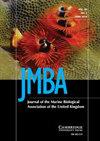打开潘多拉的盒子:巴西红心贻贝(双壳类:瓣鳃纲)分类混乱的诊断特征
IF 0.9
4区 生物学
Q3 MARINE & FRESHWATER BIOLOGY
Journal of the Marine Biological Association of the United Kingdom
Pub Date : 2024-02-12
DOI:10.1017/s0025315424000031
引用次数: 0
摘要
红心蝠属(Cardiomya)尚未解决的系统学问题导致了一系列令人震惊的鉴定错误。造成这种情况的原因是标本的稀有性,更重要的是对哪些特征与该属分类相关缺乏了解。在这项研究中,我们开发了一种基于标准线性判别分析的方法,以确定能够有效区分巴西红心蝠属物种个体的最小数量的形态特征。从拍摄的 Cardiomya 贝壳中获得的 29 个形态测量值中,我们只鉴定出了五个特征:喙背侧弯、肋骨最后端到脐部后缘的距离、45°、15° 和 -30° 角的瓣膜中心点到前缘的距离。令人惊讶的是,所有这些特征都与外壳轮廓有关,而与装饰无关,而装饰是红心瓣鳃纲的一个显著特征。我们专门使用肋骨总数进行了单因素方差分析和事后的 Tukey HSD 检验,以验证其在物种鉴定中的鉴别力。我们的分析表明,肋骨的数量在所分析的物种之间并不存在显著差异。本文章由计算机程序翻译,如有差异,请以英文原文为准。
Opening Pandora's box: diagnostics characters for the confuse taxonomy of the Brazilian Cardiomya (Bivalvia: Cuspidariidae)
The unsolved systematics of the genus Cardiomya has led to a sequence of astonishing identification mistakes. This scenario is a result of the rarity of specimens and, more importantly, the lack of knowledge about which characters are relevant to the genus taxonomy. In this study, we developed a method based on standard linear discriminant analysis to identify the smallest number of morphological characters that efficiently distinguish individuals at the species level of Brazilian Cardiomya . Starting from 29 morphometric measurements obtained from photographed Cardiomya shells, we were able to identify only five characters: the dorsal inflection of the rostrum, the distance from the posterior most rib end to the umbonal posterior margin and the distance from the central point of the valve to the anterior margin at 45°, 15° and −30° angles. Surprisingly, all these characters are related to the shell outline and not the ornamentation, which is a remarkable character in Cardiomya . We performed a one-way ANOVA with post-hoc Tukey HSD test specifically using the total number of ribs to verify its discriminant power in species identification. Our analysis demonstrated that the number of ribs does not show a significant difference between the analysed species.
求助全文
通过发布文献求助,成功后即可免费获取论文全文。
去求助
来源期刊
CiteScore
2.30
自引率
8.30%
发文量
68
审稿时长
3-8 weeks
期刊介绍:
JMBA is an international journal, publishing original research on all aspects of marine biology. It includes pioneering work taking place today on major issues concerning marine organisms and their environment. Subjects covered include: ecological surveys and population studies of marine communities; physiology and experimental biology; taxonomy, morphology and life history of marine animals and plants; and chemical and physical oceanographic work. Included with 2010 online subscriptions: Marine Biodiversity Records.

 求助内容:
求助内容: 应助结果提醒方式:
应助结果提醒方式:


